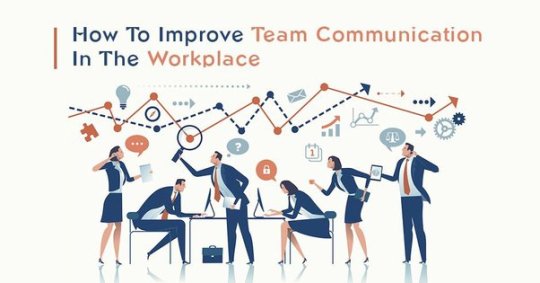#workplace collaboration
Explore tagged Tumblr posts
Text
Strategies for Effective Collaboration

Collaboration is a cornerstone of organizational success. It involves individuals and teams working together toward common goals, sparking innovation, driving productivity, and fostering a culture of teamwork. However, with diverse perspectives, cultural nuances, and varied work styles, achieving effective collaboration can be a nuanced challenge. This guide explores actionable strategies to enhance workplace collaboration, ensuring your teams function synergistically.
The Pillars of Collaboration: Setting the Foundation
1. Clearly Define Goals and Objectives
Every successful collaboration begins with a shared understanding of the goals. When objectives are clearly outlined, team members can align their efforts seamlessly. A defined purpose prevents misunderstandings, streamlines workflows, and fosters collective accountability. Consider using tools like SMART goals to ensure objectives are specific, measurable, achievable, relevant, and time-bound.
2. Establish Open Communication
Communication is the lifeblood of collaboration. Open channels encourage idea-sharing, feedback, and problem-solving. Establish clear protocols—like weekly check-ins or collaborative platforms (e.g., Slack, Microsoft Teams)—to keep everyone informed and engaged. Transparency not only ensures alignment but also fosters trust and inclusivity.
Building Inclusive and Adaptive Teams
3. Encourage Diversity and Inclusion
Diversity enhances collaboration by bringing varied perspectives and experiences to the table. An inclusive environment values every voice, encouraging innovative solutions and fostering empathy. Simple initiatives, like cultural sensitivity training or diverse hiring practices, can significantly enhance team dynamics.
4. Define Roles and Responsibilities
Clarity in roles eliminates ambiguity and prevents overlaps. Assigning responsibilities ensures every team member knows their contribution to the bigger picture. Use RACI matrices (Responsible, Accountable, Consulted, and Informed) to clearly delineate roles, boosting efficiency and accountability.
Adaptability and Accountability: Navigating Challenges
5. Foster Flexibility and Adaptability
In dynamic work environments, adaptability is key. Encourage teams to pivot when challenges arise, fostering resilience. Flexible approaches not only keep projects on track but also nurture a growth mindset among team members, leading to continuous improvement.
6. Establish Accountability Mechanisms
Accountability ensures commitment. Regular updates, performance tracking tools, and clear timelines help teams stay on course. A culture of accountability motivates individuals to deliver their best, aligning personal responsibilities with organizational goals.
Celebrating Milestones and Continuous Learning
7. Celebrate Successes and Learn from Failures
Recognizing achievements boosts morale and reinforces positive behaviors. Similarly, viewing failures as learning opportunities fosters a culture of improvement. Celebrating milestones and conducting post-mortem analyses on projects help teams refine their strategies and build resilience.
Practical Applications for Effective Collaboration
Leverage Technology
Modern tools can bridge communication gaps and streamline workflows. Platforms like Asana, Trello, and Zoom facilitate task management, virtual meetings, and collaborative brainstorming.
Develop Emotional Intelligence
Empathy and emotional intelligence enhance interpersonal relationships. Training programs focusing on self-awareness, empathy, and conflict resolution can elevate team dynamics.
Promote Cross-functional Collaboration
Encouraging teams to work across departments broadens perspectives and unlocks synergies. Cross-functional projects enable knowledge-sharing and foster innovative problem-solving.
Conclusion
Strategies for effective collaboration at work are essential for driving organizational success. By defining goals, fostering open communication, embracing diversity, and encouraging adaptability, organizations can unlock the full potential of their teams. Recognizing achievements and learning from challenges further strengthen collaboration, paving the way for sustained growth and innovation. Implement these strategies to transform your workplace into a hub of productivity and teamwork.
#Strategies for collaboration#workplace collaboration#teamwork tips#collaboration strategies#workplace productivity
0 notes
Text
Corporate Bonding beyond the Office: Event Planning Tips for Team Building
In today’s dynamic workplace, team building activities for employees play a vital role in fostering trust, collaboration, and overall productivity. A well-executed team-building event goes beyond just fun; it’s a strategic tool to strengthen relationships, improve communication, and boost morale. Whether it’s an outdoor adventure, a virtual session, or a hybrid event, thoughtful planning ensures lasting impact and meaningful engagement.
At Hire4Event, we specialize in curating innovative and impactful corporate team building activities tailored to your unique organizational needs. With a proven track record of delivering exceptional experiences, we ensure your team-building initiatives inspire collaboration, creativity, and camaraderie.
Let us help you transform your team into a cohesive, motivated powerhouse ready to achieve greater success. Contact us today to discover how we can elevate your company team building activities and create unforgettable moments for your team. Together, let’s build a stronger workplace!
📞 Call: +91-9810617123 📧 Email: [email protected] 🌐 Visit: www.hire4event.com 📍 Address: 214, ABC Tower, Sec-135, Noida-201301
#Corporate team building#Corporate team building activities#Employee bonding ideas#Event planning tips#Fun team building activities#Outdoor corporate events#Team engagement activities#Workplace collaboration
0 notes
Text
5 Proven Strategies to Attain Intranet Excellence

Modern businesses invest heavily in company intranets to boost workplace productivity, collaboration, and operational efficiency. Certainly, it helps gain a competitive edge over industry peers. However, evaluating the existing intranet settings against the standard best practices becomes crucial to maximizing the investment.
'Intranet benchmarking,' the process of assessing the intranet's features, effectiveness, and performance, proves beneficial to understand if your intranet is aligned with the organizational goals and caters to your industry-specific requirements.
Let's explore five proven strategies to get the best out of your intranet ecosystem.
Come up with a user-centric design
An easily navigable mega menu, engaging home page, robust search mechanism, and interactive web parts make it easy for employees to perform their tasks better, eventually contributing to enhanced productivity and overall satisfaction. Conduct thorough research on what your employees need the most and customize the platform accordingly. Help your employees stay updated with the latest organizational happenings, access documents, share information, and easily engage with coworkers to match the requirements and preferences of the users.
Focus on creating a collaborative workplace
To what extent is your intranet fostering workplace collaboration? Enhancing workplace collaboration is undoubtedly one of the primary reasons for organizations opting for a digital solution. However, having a centralized place for employees to organize, co-author, share documents, assign, and track tasks, and access uninterrupted communication channels can contribute to higher employee engagement and a sense of responsibility with shared goals.
Design automated and streamlined workflows
Redundant and repetitive tasks are prone to errors and are time-consuming. At the same time, an intranet automating standard workflows can be a game changer for organizations striving for enhanced workplace productivity. Try automating the approval processes for standard documents and forms, reminders and notifications for hassle-free task tracking, feedback, employee onboarding, and more, reducing manual intervention and improving overall efficiency.
Opt for a solution with seamless integration capabilities
Integration capability is a key benchmark while opting for a robust intranet solution. An intranet that seamlessly integrates with various applications and databases facilitates efficient data flow and helps users leverage powerful features without even leaving the intranet ecosystem. A SharePoint intranet integrated with Microsoft 365 productivity applications allows users to access Teams, Outlook, Delve, Power BI, and more, making it easy for them to perform various tasks with utmost ease.
Ensure proper user training and support
An intranet goes through functional issues and needs proper maintenance, security audits, and a performance optimization plan for continuous improvement. So, opting for a reliable service provider too becomes crucial while benchmarking your intranet solution. For nearly all technologies, including the intranet, adequate user training is imperative to ensure high user adoption rates and proficiency. However, SharePoint-based intranet requires less training due to its intuitive user interface, consistency across applications, unified collaboration platform, and familiar Microsoft 365 environment.
The intranet serves as a backbone for modern organizations. However, achieving intranet excellence is a strategic process that can only be achieved with a balanced approach. From clean and navigable design to timely maintenance and support, every aspect contributes together to create a robust intranet platform that drives collaboration, productivity, and innovation, ensuring overall organizational success.
0 notes
Text
Nurturing psychological safety for diverse voices in the C-Suite

In the fast-evolving landscape of the modern workplace, where diversity, equity, and inclusion (DEI) are paramount, nurturing psychological safety has never been more critical. Leaders play a pivotal role in establishing and nurturing psychological safety within their teams, setting the tone and modeling the behaviors they wish to see in others.
How Leaders Create Psychological Safety at Work
Leaders have a unique responsibility to lead by example and create an environment where every voice is heard and valued. Practical steps can help foster psychological safety:
Also Read: The Role of the C-Suite in Promoting Global Diversity Awareness
1.1 Lead by Example:
The decisions you make as a leader establish the tone for the team. Consider the example of Microsoft CEO Satya Nadella. He openly admitted to past mistakes in how Microsoft approached diversity, vowing to make changes. This kind of vulnerability demonstrates that mistakes can be acknowledged and rectified, setting a powerful precedent.
1.2 Foster Inclusive Communication:
A shining example of fostering inclusive communication comes from Johnson & Johnson. They established a practice of equitable airtime during meetings and recognized that diversity of thought is essential for innovation. This resulted in a workplace where diverse voices are celebrated.
1.3 Establish Psychological Safety Norms:
A prime example of establishing psychological safety norms can be seen at Google. They co-created a “Googley” code of conduct with an emphasis on respectful communication. By holding employees accountable for these norms, Google maintains a culture of psychological safety.
Why Workplace Psychological Safety Matters Now More Than Ever
Psychological safety and DEI are inextricably linked. Actively removing barriers to participation and guaranteeing fair chances for all team members are necessary for creating an inclusive atmosphere. Google, once again, is a case in point. They found that teams with higher psychological safety were more likely to succeed, emphasizing the importance of fostering an inclusive environment.
Explore HRtech News for the latest Tech Trends in Human Resources Technology.
1 note
·
View note
Text
Man it is worth pointing out that the ACA is a living piece of legislation. Like every year updated protocols and guidelines release to the whole industry from CMS (gov oversight) and I educate professionals in my field on the changes each time. It was built intentionally to be an evolving and improving system that can handle more and more people each year. The ACA is not a stone tablet; it's an arm of federally protected benefits like Medicare that is inherited and maintained and built up by sequential administrations. It is WORKING, it's so reassuring to see it become so intertwined with our American health care model that an entire wing of the industry is now dedicated to the ACA.
Yeah, we want a better health care system, of course we do!! That's why so many people dedicate their careers to supporting the ACA!!! THIS is the fish crawling onto land that can eventually become a health care system that treats us with dignity. We just have to keep evolving it into a more equitable and accessible option. I vote with my head mostly tuned into future health care + research policies and it makes my goals much clearer. Biden has spent 2 separate administrations leading the Cancer Moonshot research funding initiative that has contributed significantly to the boom in cancer breakthroughs. Trump suggested we drink bleach for covid. I trust one significantly more than the other to continue funding ACA and NIH initiatives and interests 🤷
#Creepy chatter#Idk I live in a red state so we are ground zero for some of the worst ACA myths that deter locals from voting in favor of pub health#So like when I look up the political ladder at those decisions....I usually have the same questions#What is your plan to continue to reduce health care costs? Do you have plans to address pharmacy patents?#Disability protections and workplace health investments?#Any plans to further legislate for-profit privatized health resources like hospitals or walk-in clinics?#There are so many federal walls that need collaboration to overcome. Either public health suffers or continues to improve.#The ACA is proof we can snowball improvement over the course of different administrations. Keep rolling it!!!
13 notes
·
View notes
Text
Beyond the Boardroom: Mixing Business with Pleasure
Mixing business and pleasure is not a fleeting trend but a comprehensive strategy that can lead to productivity and improved well-being.
In the modern business landscape, the age-old adage of “never mix business with pleasure” seems to be undergoing a significant transformation. As the lines between professional and personal lives increasingly blur, a new paradigm emerges, advocating for a harmonious blend of business activities with leisure pursuits. This approach, often encapsulated in the phrase “mixing business and pleasure,”…

View On WordPress
#adaptive work cultures#balance in professional settings#boundary setting#business and leisure integration#business innovation#career advancement#collaboration techniques#corporate culture evolution#corporate retreats#creative inspiration#cultivating professional friendships#digital nomad lifestyle#diversity and inclusion#effective communication#employee well-being#engaging work experiences#enhancing team cohesion#entrepreneurial lifestyle#flexible work arrangements#fostering creativity in the workplace#hybrid work models#inclusivity in the workplace#innovative business practices#job satisfaction enhancement#leisure activities in business#leisure-driven productivity#modern workplace dynamics#navigating professional landscapes#networking strategies#personal and professional growth
2 notes
·
View notes
Text
Today's conversations have taken some weird turns but crucially they have all been very funny.
#love collaborating on increasingly bizarre workplace scenarios#evil empire military socials are now getting filed next to Extreme Thursdays
8 notes
·
View notes
Text
Harmonizing Productivity: The Mystical Impact of Music in the Workplace
What do you listen to while you work? Unravel the enigmatic influence of music on work performance and navigate through an exhilarating journey of curated playlists, optimizing productivity in unforeseen ways. Embark on a mind-boggling exploration into the scientific symphony of music’s sway on your work environment and find the perfect harmonies for an unparalleled work…

View On WordPress
#Boosting focus#Creative inspiration#Curated playlists#dailyprompt#dailyprompt-2006#Future of work#Music and productivity#music genres#Music psychology#noise-canceling headphones#Productivity optimization#Stress-relief techniques#Team collaboration#Work-life balance#Workplace ambiance
3 notes
·
View notes
Text
Life Lessons from the Idiomatic Expressions 'One Bird Doesn't Make a Swallow' and 'One Tree Doesn't Make the Woods'
The phrases “One bird doesn’t make a swallow” and “One tree doesn’t make the woods” are idiomatic expressions that convey a deeper meaning beyond their literal interpretation. These expressions suggest that a single entity or occurrence cannot represent the whole and that a complete picture requires many elements or factors. The phrase “One bird doesn’t make a swallow” implies that a single…

View On WordPress
#Collaboration in Business#Diversity in the Workplace#Management Skills#Patience and Persistence#Personal Development#Stereotype Avoidance#Teamwork
2 notes
·
View notes
Text
Silence Speaks Volumes: Fostering Inclusive Communication
Are you overlooking the valuable contributions of your quieter team members? Read Now!
Communication is the lifeblood of any organization, shaping how ideas are shared, decisions are made, and teams collaborate. In many corporate offices, understanding the nuances of communication is particularly crucial. Cultural norms, individual preferences, and organizational structures all interact to create a unique communication ecosystem. This ecosystem, while often vibrant and energetic,…
#collaboration#communication#diversity#hr#inclusion#introverts#leadership#strategy#Teamwork#workplace
0 notes
Text
Collaboration strategies

Learn to establish open communication and accountability for effective teamwork.
#Collaboration at Work#Teamwork Strategies#Workplace Productivity#Effective Communication#Diversity and Inclusion#Workplace Collaboration#Team Dynamics#Innovation and Teamwork
0 notes
Text
Future of Work Like Remote Collaboration Tools
Learn about the latest advancements in remote collaboration technology and its impact on the future of work. A wonderful tranquility has taken proprietorship of my entirety soul, like these sweet mornings of spring which I appreciate with my aggregate heart. I am so playful, my costly companion, so ingested inside the astonishing sense of immaterial quiet nearness, that I neglect my…
0 notes
Text
Team communication in the workplace
What is Team Communication?
Team communication is the exchange of information inside or across teams. The best way to demonstrate the adage "teamwork makes the dream work" is through efficient team communication at work. At work, efficient team communication allows everyone to be aware of any issues, which improves operations. Additionally, it fosters employee involvement, trust, morale, and camaraderie in the workplace.

Employee connections will be strained and productivity will be decreased if workers operate alone and in silos. Team communication is crucial to achieving objectives in a focused and coordinated way.
As they say,
Two people are needed to tango. Without creating a communal work culture among its personnel, no organisation can afford to advance.
The demands of relating across several platforms to accomplish the shared goal of work might occasionally cause communication to become strained. This is where effective team communication is crucial.
As a team's size increases, it is essential that the communication channel become more intelligent, seamless, and, of course, secure. For the entity's overall advantage, this promotes solid and enduring teamwork.
Planning strategies to enhance workplace communication makes a lot of sense because this is essential.
Effective team communication is difficult to get, but a concentrated effort will guarantee that all employees, regardless of location, are on the same page.
1. Gel Well
Using inclusive tactics helps team members develop a good outlook and effective communication skills.
Information sharing within the company will be more honest, transparent, and based on greater trust.
To promote a fair and honest exchange of thoughts and viewpoints regarding work, the team leader should make sure to build a personal rapport with each member of the team. Working in silos is far worse than using participatory management and working methods.
2. Instill Trust
When do you believe you'll be accepted by your community?
Is it your wealth, your attractiveness, your power? These traits could actually "force" coworkers and subordinates to comply rather than guarantee a sincere and dedicated reaction to work.
Allow your actions to speak for themselves. Set a good example and encourage greater levels of trust and teamwork among your staff. To create more equitable relationships and promote a positive work culture, demonstrate real interest in and empathy for others. Nearly one-third of workers have a favourable dislike for their bosses, according to multiple surveys.
When do you believe you'll be accepted by your community?
Is it your wealth, your attractiveness, your power? These traits could actually "force" coworkers and subordinates to comply rather than guarantee a sincere and dedicated reaction to work.
Allow your actions to speak for themselves. Set a good example and encourage greater levels of trust and teamwork among your staff. To create more equitable relationships and promote a positive work culture, demonstrate real interest in and empathy for others. Nearly one-third of workers have a favourable dislike for their bosses, according to multiple surveys.
3. Get to know individuals better
A blanket opinion about the staff is a big no when it comes to managing them. Take time, understand each individual, and know their strengths.
By understanding each other’s strengths and weaknesses, it’s easier to have effective team communication in the workplace.
No two personalities resemble fully. Comprehend the subtle variations in moods, responses, and reactions of one and all to varying situations at work.
4. Provide a level playing field
The ability to respect diversity begets positive vibes in the work environment.
Respect differing styles of working as long as the ultimate goal is not vitiated by divergent work styles.
While some may prefer team chat, some may depend on face-to-face interaction. However, both come under team communication skills.
Factor such preferences wherever possible and feasible to promote seamless communication among and with peers and staff.
5. Team Collaboration
Excellent team communication develops a workplace where everyone develops skills and ideas to help them become more educated about duties to various degrees by collaborating as a team instead of as individuals.
What are the different types of team communication?
Some of the different types of team communication are as follows:
Verbal: As was already established, one-on-one interaction is the ideal way to nurture effective team communication. Paying attention to one another and the dialogue promotes a sense of value and credibility. Face-to-face talks allow you to examine your team member successfully.
Body Language: Body language is a method of communication in which information is expressed or conveyed via bodily behaviors rather than words. This behavior includes facial expressions, body posture, gestures, eye movement, touch, and the use of space.
Written Communication: Any interaction that uses the written word is considered Written communication which involves expressing yourself clearly, using precise language, constructing a logical argument; note-taking, editing, summarising; and writing reports.
Visual Communication: Visual communication conveys information and ideas using symbols and visuals. It is based on actions that convey concepts, viewpoints, and values using visual materials like text, images, or video. Given that the message or information is communicated using a visual medium, visual communication is considered one of the best team communication styles most likely to impact and foster improved comprehension significantly.
Conclusion
In the unified chat app industry, there are several business chat applications that fulfil users' diverse needs and provide a wide range of features. Most of these team communication platforms charge users on a monthly basis, although a few provide free services with improved security features. Since improving team communication is the key to success, make well-informed judgements.
#team communication#team communication in the workplace#effective team communication#team communication tools#troop messenger#communication#collaboration#instant messaging app#workplace commnuication
1 note
·
View note
Text
How Workplace Communication Shapes Leadership Effectiveness
💬 The Secret to Great Leadership? Mastering Workplace Communication! Effective leaders know that communication is the foundation of success. Without clear messaging, open dialogue, and active listening, even the best strategies fall apart. Strong communication helps leaders: ✔ Build trust and credibility ✔ Align teams with organizational goals ✔ Foster collaboration and innovation ✔ Boost employee engagement and morale But communication isn’t just about talking—it’s about listening, adapting, and creating a culture of transparency. Leaders who master communication create high-performing teams that thrive. 📢 What communication strategies have helped you become a better leader? Let’s discuss! #Leadership #Communication #EmployeeEngagement #WorkplaceSuccess #TrustMatters #Influence #Teamwork
Introduction Communication is the foundation of effective leadership. No matter how skilled or knowledgeable a leader may be, their success is often determined by how well they communicate their vision, inspire their team, and foster collaboration. In today’s fast-paced and highly connected workplace, strong communication skills are more critical than ever. Leaders who communicate effectively…
#active listening#business communication#company culture#Effective Leadership#employee engagement#leadership communication#leadership development#open dialogue#team collaboration#trust in leadership#workplace culture#workplace transparency
1 note
·
View note
Text
Inside the Creative Minds Behind 'Mythic Quest' Season 4 with Ashly Burch and Megan Ganz
Ashly Burch & Megan Ganz Interview by Big Gold Belt Media with @AshleynCompany –Synopsis:Back under the same florescent office lights, the reunited team at Mythic Quest confronts new challenges amongst a changing video game landscape as stars rise, egos clash, relationships bloom and everyone tries to have a little more “work work” life…
0 notes
Text
The Cycle of Jobless Recovery: A Call for Inclusion in Tech
By WPS News Technology ReportersBaybay City | January 23, 2025 The term “jobless recovery” describes a situation where the economy shows signs of recovery from a recession, yet the unemployment rate remains stubbornly high. This phenomenon was particularly notable in the early 2000s, following the 2001 recession in the United States, marking a time when many skilled workers found themselves…
#age discrimination#AI advancements#economic recovery#generational collaboration.#Inclusion#jobless recovery#skilled workers#tech industry#underemployment#workplace culture
0 notes